13 Sustainable Decorating Tips For An Eco-Friendly Home
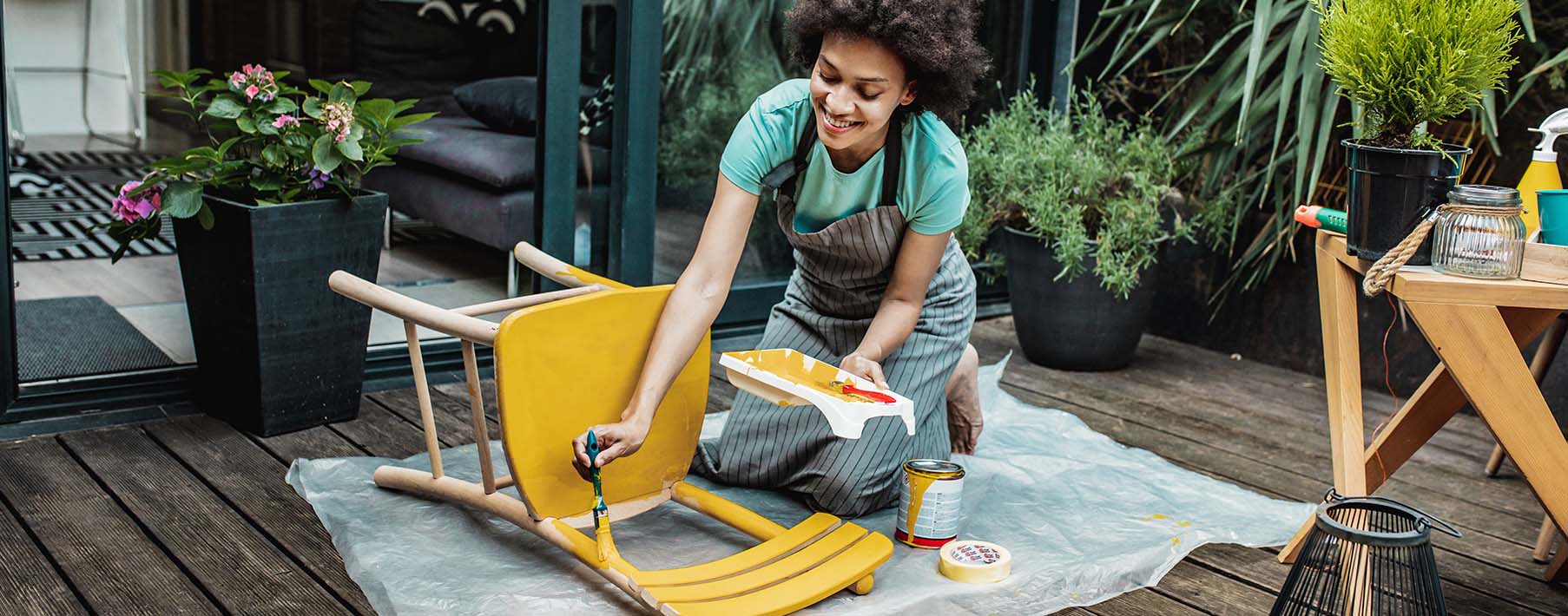
We all know the feeling we get when we walk into a well-designed space. From mood lighting to calming colors, our environment has the ability to boost our mental wellbeing and relax us in one fell swoop.
Now, imagine that you walk into a well-curated home that makes you relaxed, then you learn it’s also helping the environment. How much more do you appreciate your surroundings? If you’re into sustainability (and who isn’t these days?) the answer is likely a lot.
You don’t need a degree in interior design to create an eco-friendly and beautiful home. All you need to do is follow the sustainable decorating tips below and you’ll be well on your way to a more beautiful and eco-friendly home.
What is sustainable decorating?
Sustainable decorating is the process of decorating your home in a way that benefits — rather than harms — the environment. By shopping secondhand, repairing older items instead of throwing them out, and focusing on shopping slow and local, you can create a beautifully curated space to feel good about.
Sustainable decorating is one of the bigger home improvement trends in recent years as consumers become more conscious of how their purchase decisions affect the environment. And it’s about time this trend took hold too. For instance, did you know that 9 million tons of furniture are added to landfills every year? Consumers are wising up to this growing waste problem, choosing instead to reuse and recycle previously loved pieces for a more sustainable space.
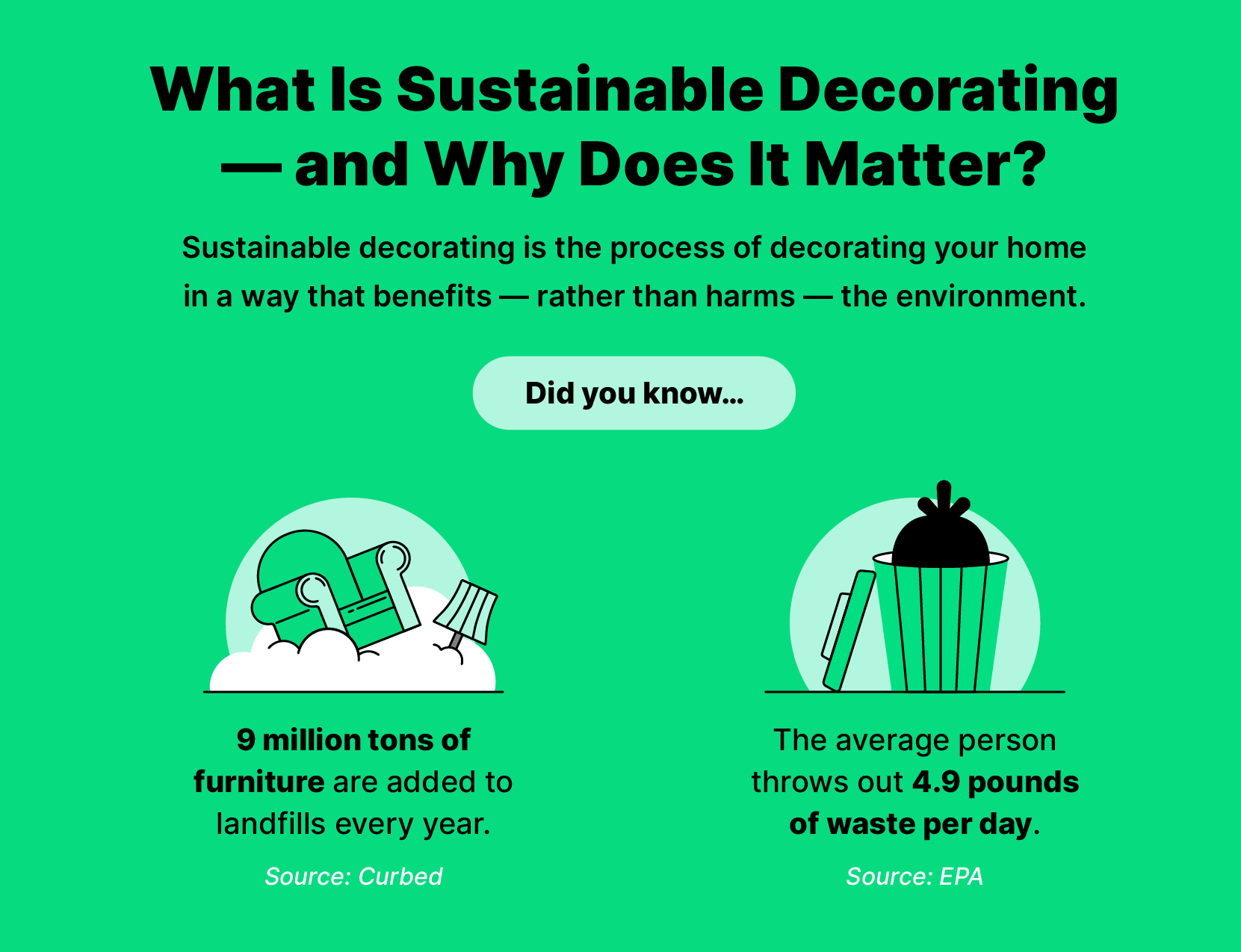
13 tips for sustainable decorating
Looking to make more eco-friendly decor decisions but don’t know where to start? Check out the below tips — useful for homeowners and renters alike — to greenify your space without sacrificing style.
1. Upcycle your old favorite pieces
If you’re itching to redecorate, don’t run to the store just yet. One of the most important steps to sustainable decorating is to avoid buying new when possible, starting with the items you already have.
Say you want to get new pillows for your couch. Instead of buying a set from the store, can you sew a favorite blanket into a new pillow cover for a sustainable refresh? Or, if you’re looking to plant some succulents, try turning an old suitcase into a funky planter instead of buying new pots. By getting creative with the items you already have, you can scratch that decorating itch without having to throw anything away or spend money.
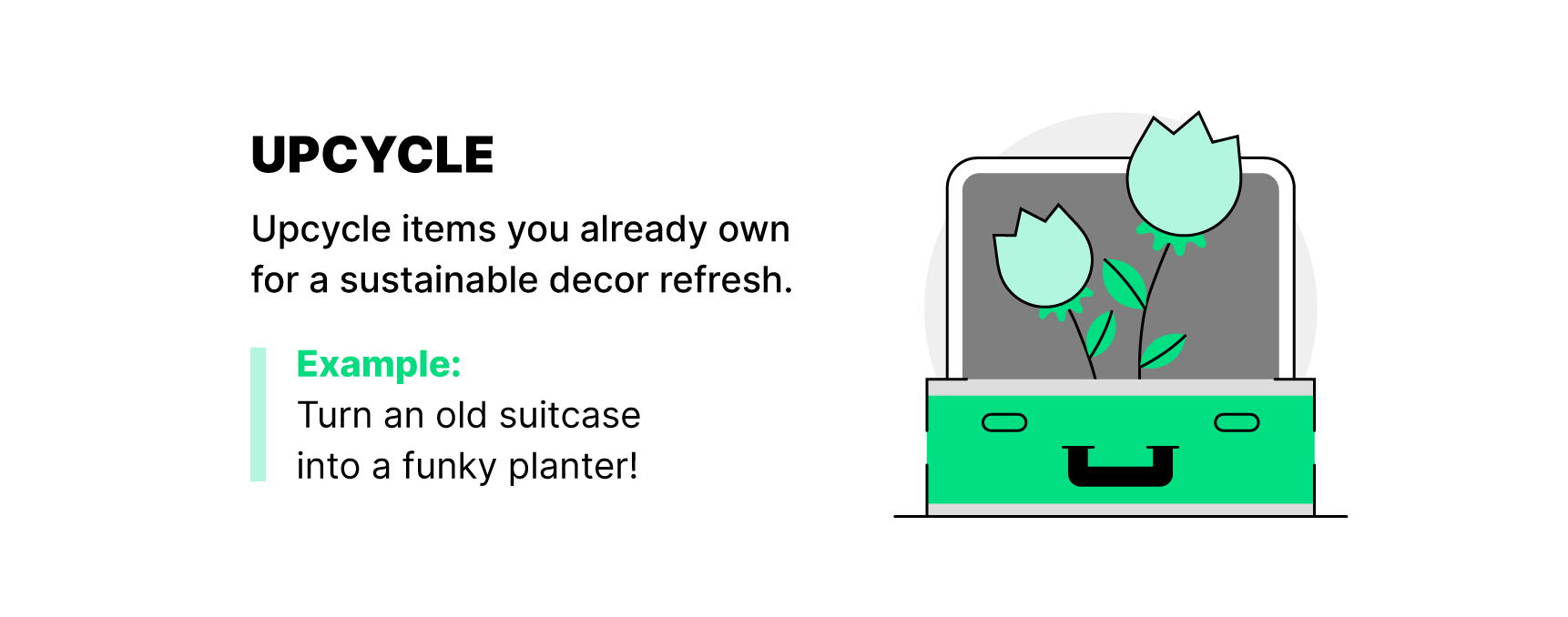
2. Buy local or handmade
When you buy something new, do you ever take a second to consider how much energy was used to get it to you? Whether you buy something in a store or have it shipped, by the time your new purchase is in your home, it’s done some real damage to the environment. There’s a lot going on behind the scenes from transportation pollutants to single-use packing materials.
One great way to help reduce your carbon footprint when it comes to buying new is to shop local and handmade. Not only does this cut down on carbon emissions from global transportation, but it also helps stimulate your local economy. So the next time you’re on the hunt for a great piece of art or a coffee table, don’t open your phone. Instead, check out the small businesses, craft fairs, and vintage stores in your area to find something you’re sure to love.
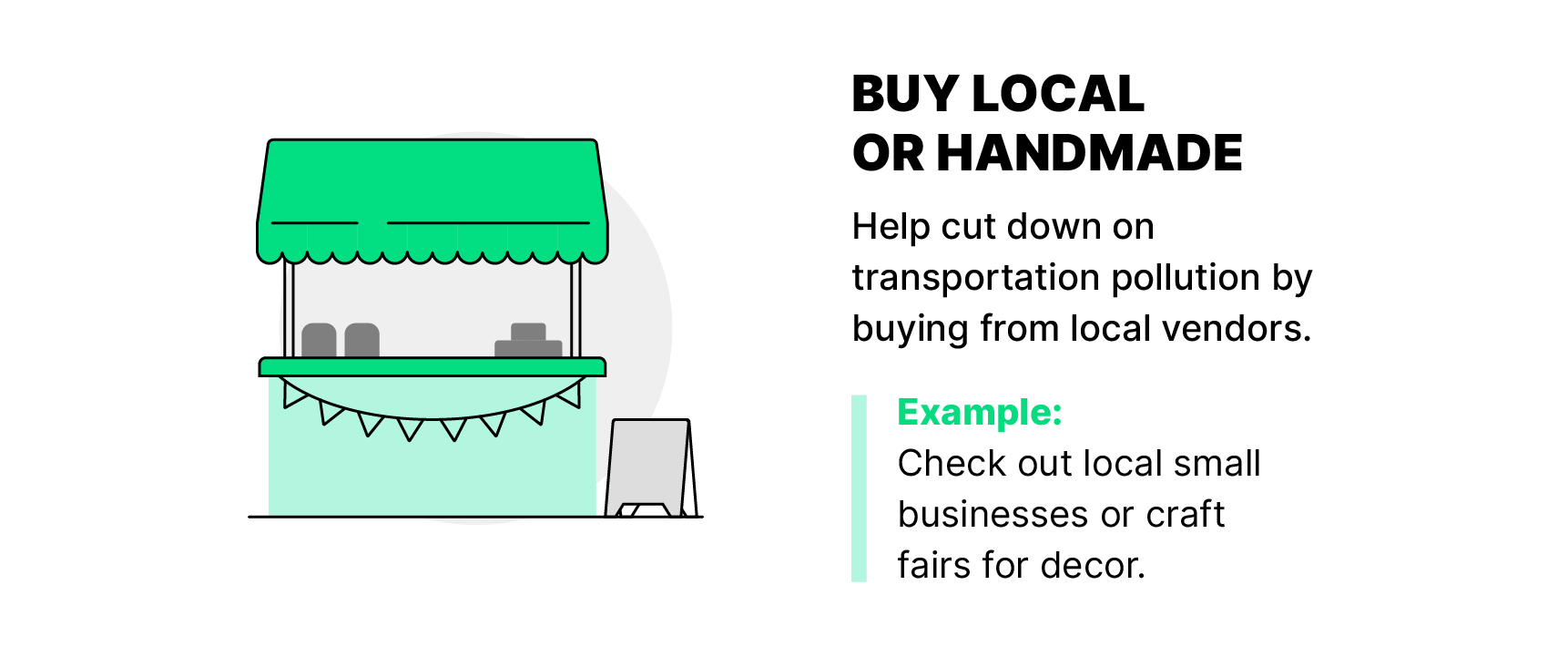
3. Shop mindfully
Though retail therapy can be a great way to relieve stress, it’s not always the most eco-friendly choice. More often than not, once the high of the purchase fades, you’ll be left wondering, “Why did I even buy this?”
Enter: mindful shopping. Mindful shopping is the process of slowing down your purchase decisions to ensure you only buy the things you really need and will use for years to come. A far cry from our “buy now” culture, mindful shopping may take some getting used to. But trust us when we say that the financial and environmental benefits will be well worth it.
Try your hand at mindful shopping by answering the following questions before checking out:
- What will I use this for?
- Do I absolutely need this, or am I buying it just to buy it?
- Do I have space for this in my home?
- What value does this bring to my life?
- How long do I expect to keep this item?
- What will the cost per use be for this item?
- Is it well made?
- Could I turn this into something else down the line?
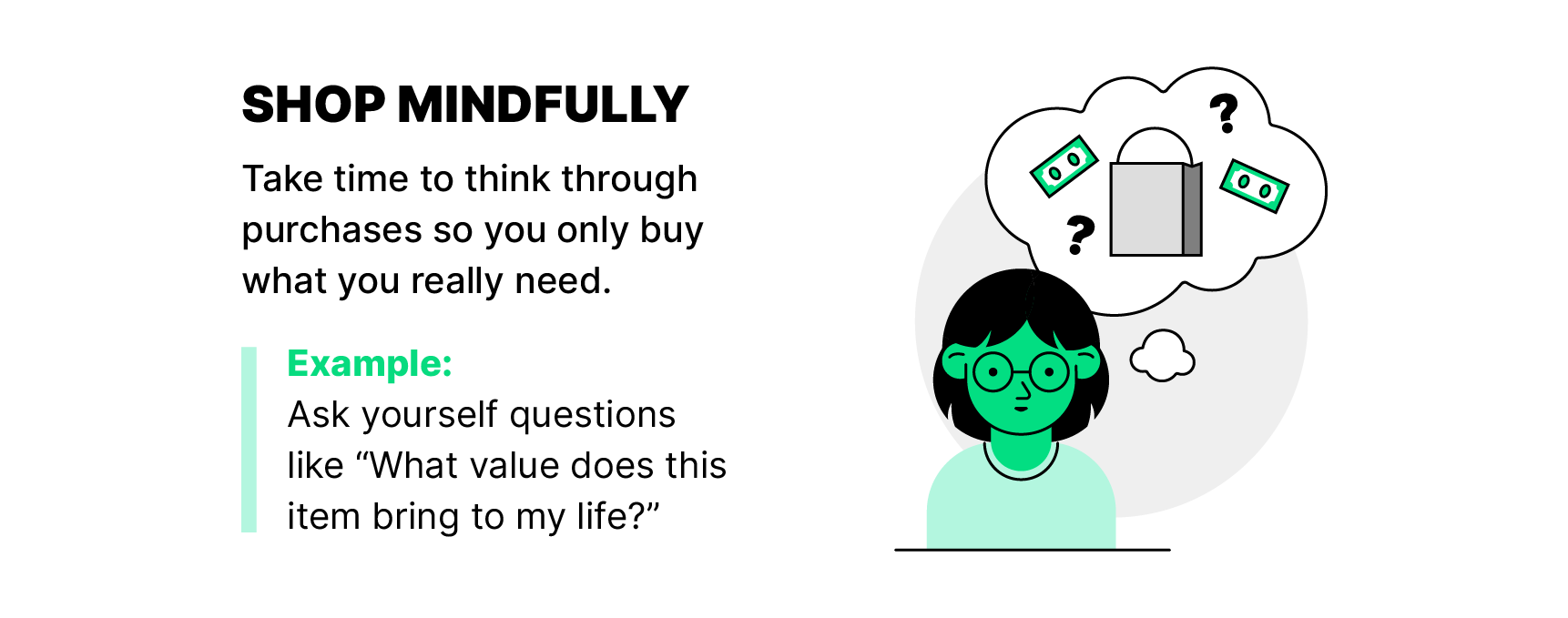
4. Try a no-buy month
One of the best ways to be sustainable is not to buy anything at all. Easier said than done, right? Make the no-buy trend more doable by committing to one month out of the year where you don’t buy any decor or furniture at all. Use this time to consider what pieces you actually need and rearrange your current decor to find a style all your own.

5. Banish plastic decor
Given that plastics can take thousands of years to decompose, anyone looking to live a more sustainable lifestyle should avoid the stuff as much as they can. Though you may have swapped out plastic bags for reusable versions long ago, you might be surprised to learn that there is plastic in many of the items you use to decorate your home.
Polyester fiber, epoxy, and even glitter — there are a lot of different names for the same material. Plastic is seemingly in everything these days, and the best way to ensure your home is sustainable is only to buy home decor items made from natural materials. Whether you buy a bamboo storage box or a glass windchime, all-natural decor ensures that you aren’t harming the environment with your purchase. Another bonus? You can easily compost or recycle the item when you’re done with it.
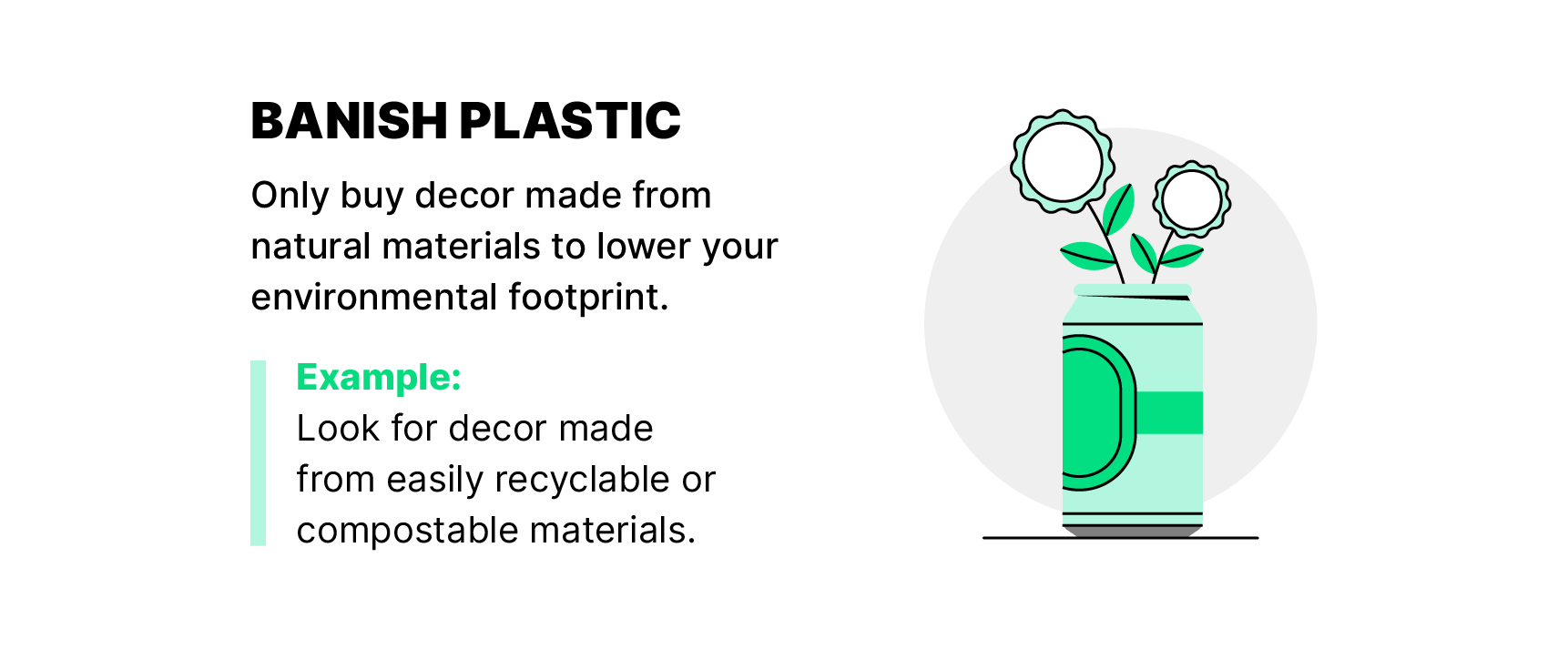
6. Swap unwanted items for new gems
The saying “one man’s trash is another man’s treasure” rings true for a reason. While you may be tired of an old piece of decor, there just might be someone in your neighborhood who would love to add your piece to their home (or vice versa). Want to see what we’re talking about? Start participating in community swaps.
Through local Facebook pages, apps like Listia, or websites like Craigslist, you can connect with people in your area to trade your unwanted items for someone else’s gems. This way you get something new, you get to declutter and you did it all without spending any money or adding to a landfill.

7. Look for eco-labels
Though it may seem counterintuitive, buying new and well-made pieces of decor or furniture can be a sustainable move if done correctly. If you shop mindfully and are willing to put more money down upfront, you’ll more than likely walk away with a piece that you’ll love (and that will last) for years to come.
Before you swipe your card, it’s important to keep an eye out for things that signal a green company. Green certifications (or eco-labels) are a great way to feel good about your purchase and ensure you aren’t giving money to companies that damage the environment. Some of the green certifications to look for include:
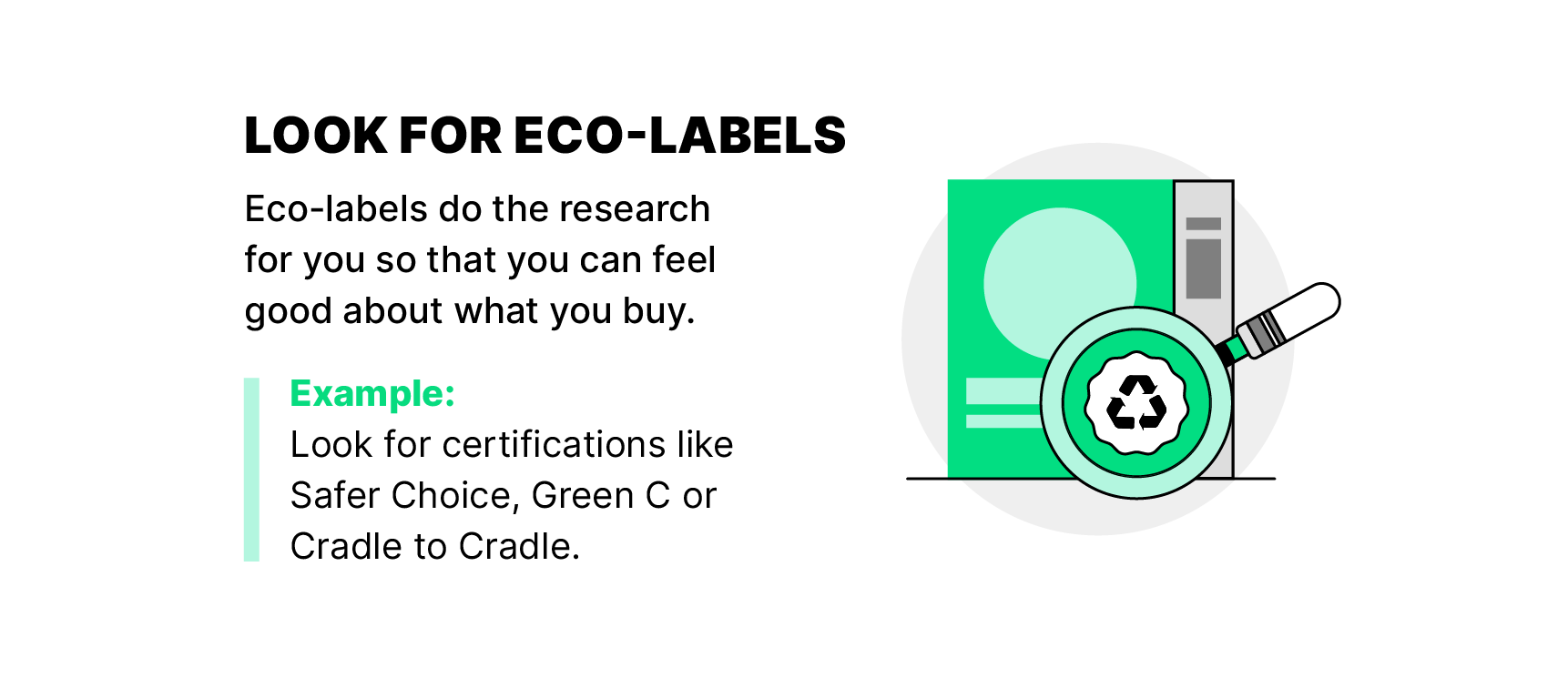
8. Go thrifting
Thrift shopping is a great way to keep unused items out of landfills and save money in the process. You can find plenty of art and furniture at places like Goodwill, Salvation Army, and local vintage shops for a fraction of what you’d pay if you bought new. Plus, you can always slap a fresh coat of paint or a new frame on anything you find for a fun and stylish update.

9. Propagate greenery
Bringing plants into the home has been proven to improve air quality and boost your mood. But if you’ve ever visited your local nursery, you know that indoor plants aren’t always cheap. Luckily, you can turn your home into a lush green space with just one plant and a little bit of patience.
By propagating your current plants, or creating new plants from cuttings of other plants, you can turn one plant into several over the course of just a few months. To propagate correctly, make sure you’re cutting off a piece with at least one node. Then, let the cutting sit in water for several weeks to grow roots. Once the roots are established, you are free to plant your new cutting in soil and watch it grow.
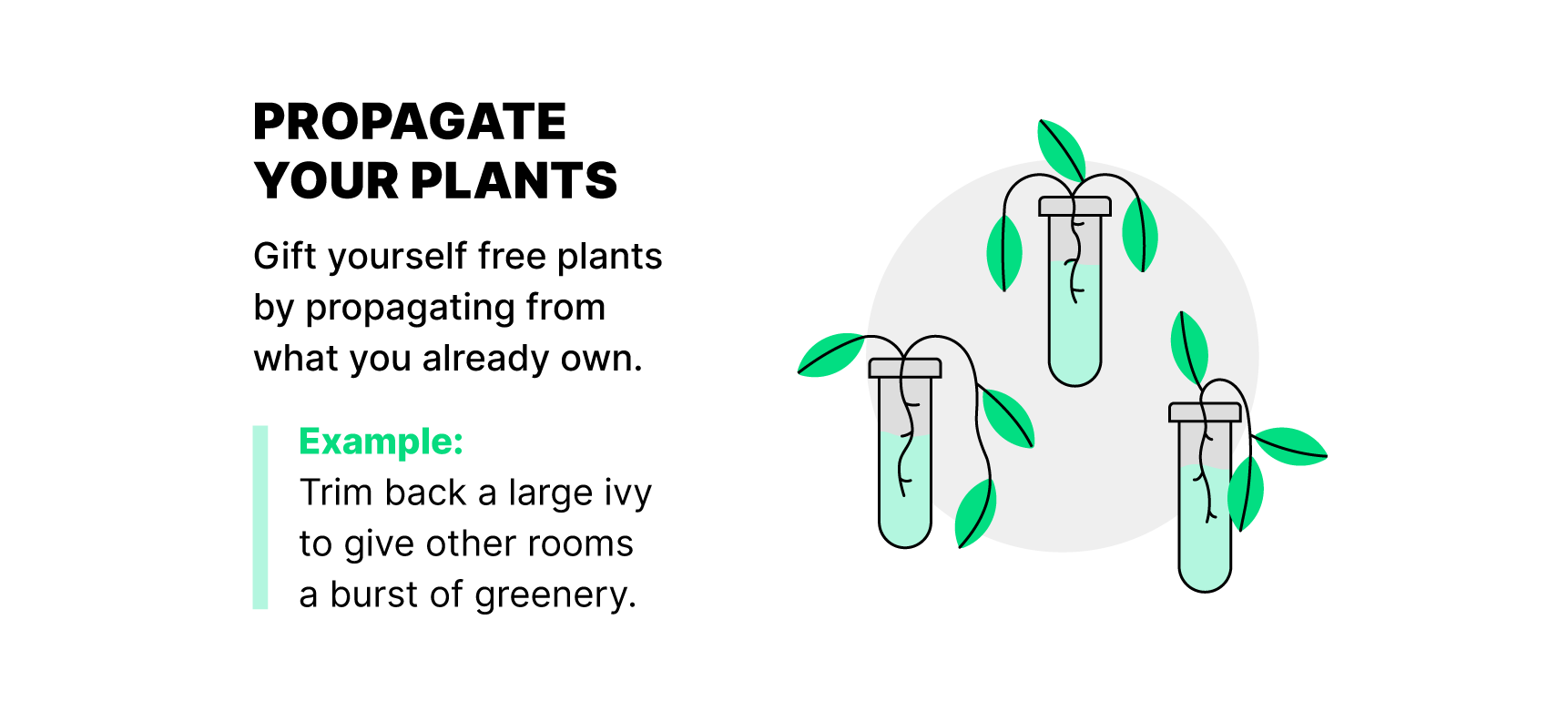
10. Focus on the big picture
To try out this sustainable decorating hack, all you have to do is take a step back and assess. Before you head out to a thrift store or begin your online shopping hunt, take inventory of what you currently have and what you actually need. This will help ensure you don’t fall into the trap of retail therapy.
When taking stock of what you own, consider focusing on one or two bigger items as focal points in each room. These should be items you truly love and plan on keeping for a long time. By keeping these items in mind, you can ensure you only buy timeless pieces of decor that will go well with these long-term focal pieces.
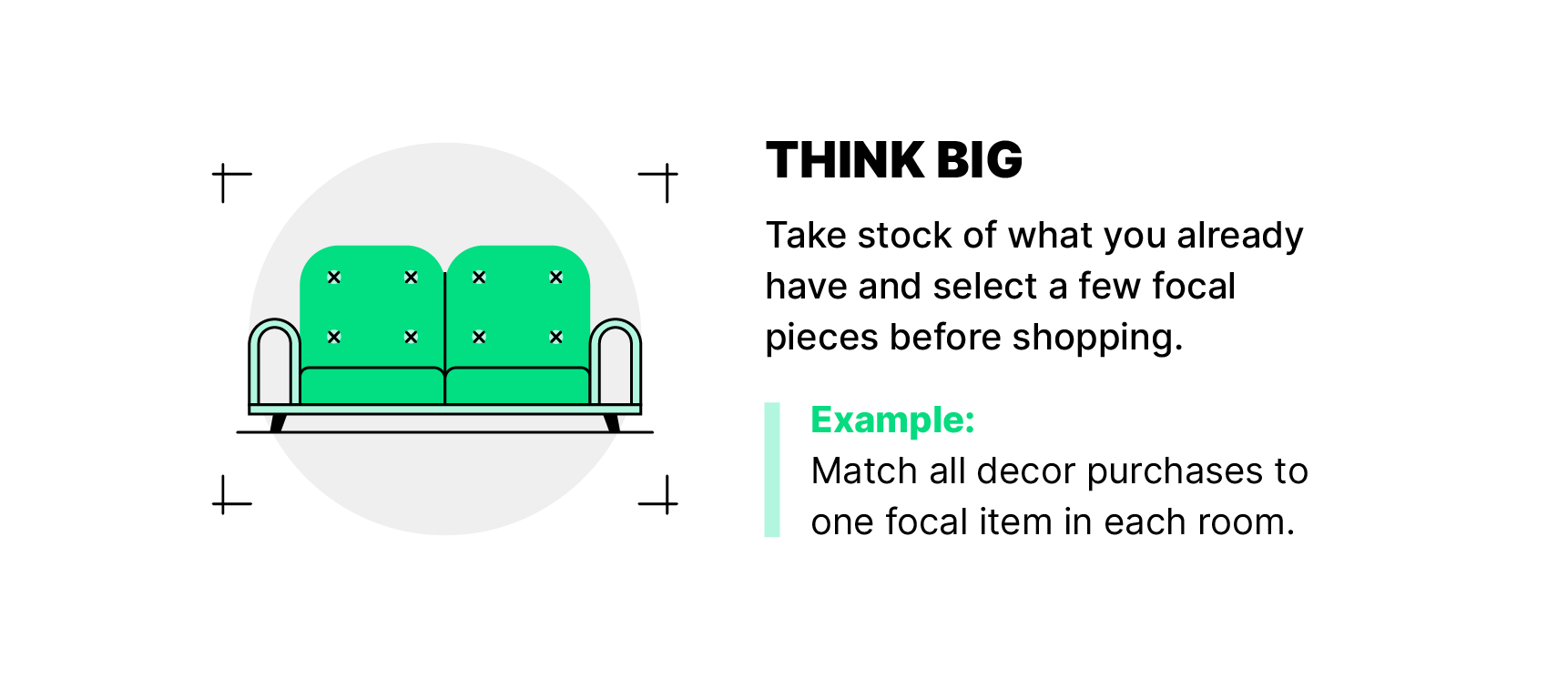
11. Rent your furniture
If you consider yourself a nomad or just change your mind a lot, rental programs like CORT and Feather are your new best friends. By renting your furniture, you can collect one-of-a-kind high-quality pieces and switch them out as often as you like without having to worry about sending them off to the landfill. It also makes moving a lot easier, meaning it can be a must for renters or cross-country movers.
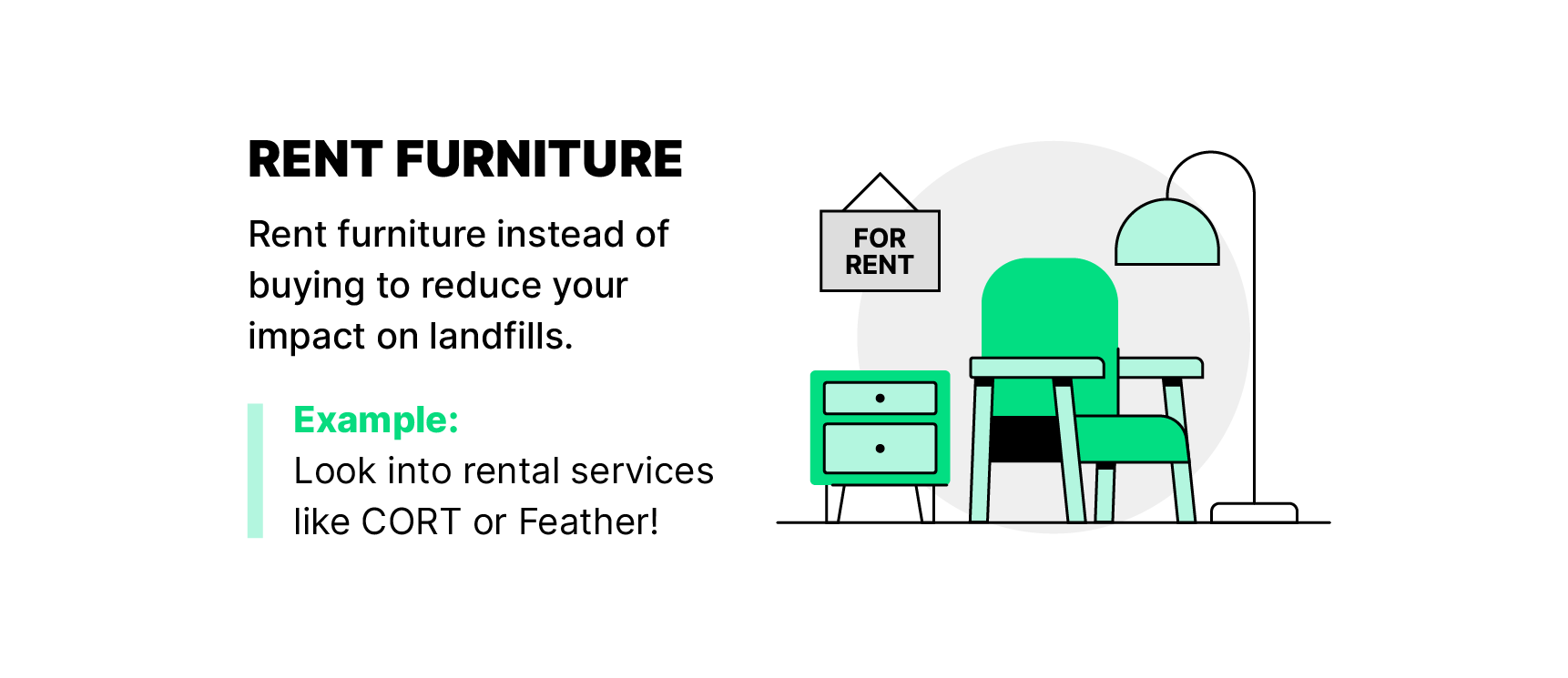
12. Be wary of greenwashing
Most companies know that consumers care about their eco-friendly practices. But unfortunately, not all companies are taking active steps to reduce their environmental footprint. Instead, they’re changing their marketing strategy to try to fool consumers into thinking they’re a green company. This tactic is known as greenwashing, and as a conscious consumer, it’s a good idea to keep an eye out for the signs.
Below are some of the most common greenwashing tactics you should know:
- An overwhelming amount of environmental images
- Unverified or outlandish claims
- Marketing strategies that focus on the lesser of two evils
- Secrecy of the lifecycle of their products
- No recycling or composting labels
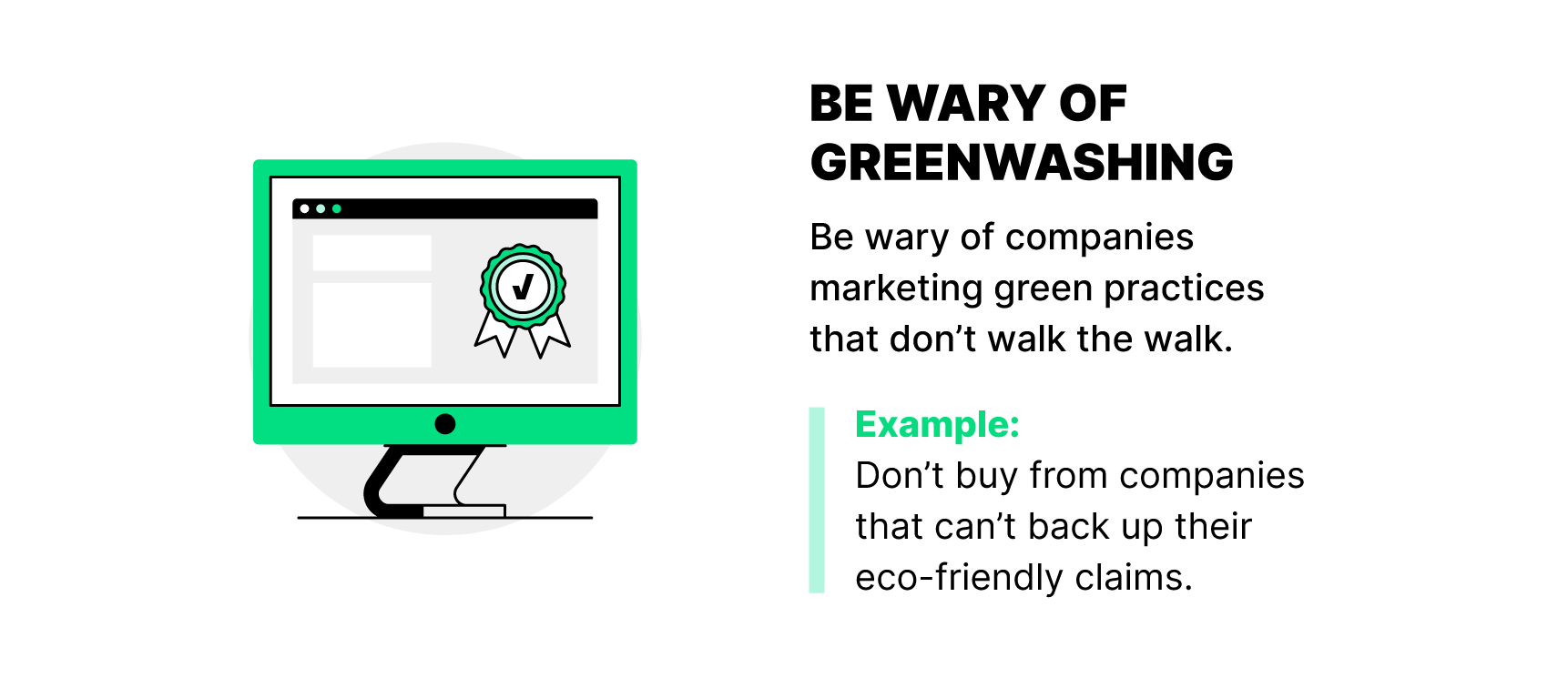
13. Don’t follow trends
Home decor trends can change on a dime, meaning what was once “in” can be “out” and in a landfill in the blink of an eye. To minimize your environmental footprint, try your best to steer clear of fast-fading trends. Instead, think outside the box and focus on style and decor choices that truly speak to you. This will lead to better long-term results and less decor waste across the board.

Why sustainability matters in your home
Sustainability is a lifestyle. While you can start with thrift shopping and propagating plants, there are plenty of other ways to lower your carbon footprint in every facet of your life. Need a little more convincing before you take the eco-friendly plunge? Check out the benefits to sustainability in your home below.
- Lower utility bills
- Higher indoor air quality
- Reduced living expenses
- Less clutter reduces anxiety and stress levels
- Improved self-worth from helping the environment
- Long-lasting and durable decor and furniture
Going sustainable in your home doesn’t stop with your decor choices. To take more steps into the world of the environmentally friendly living, consider installing solar panels, adding eco-friendly landscaping, xeriscaping your yard, or updating your appliances to energy-efficient versions.
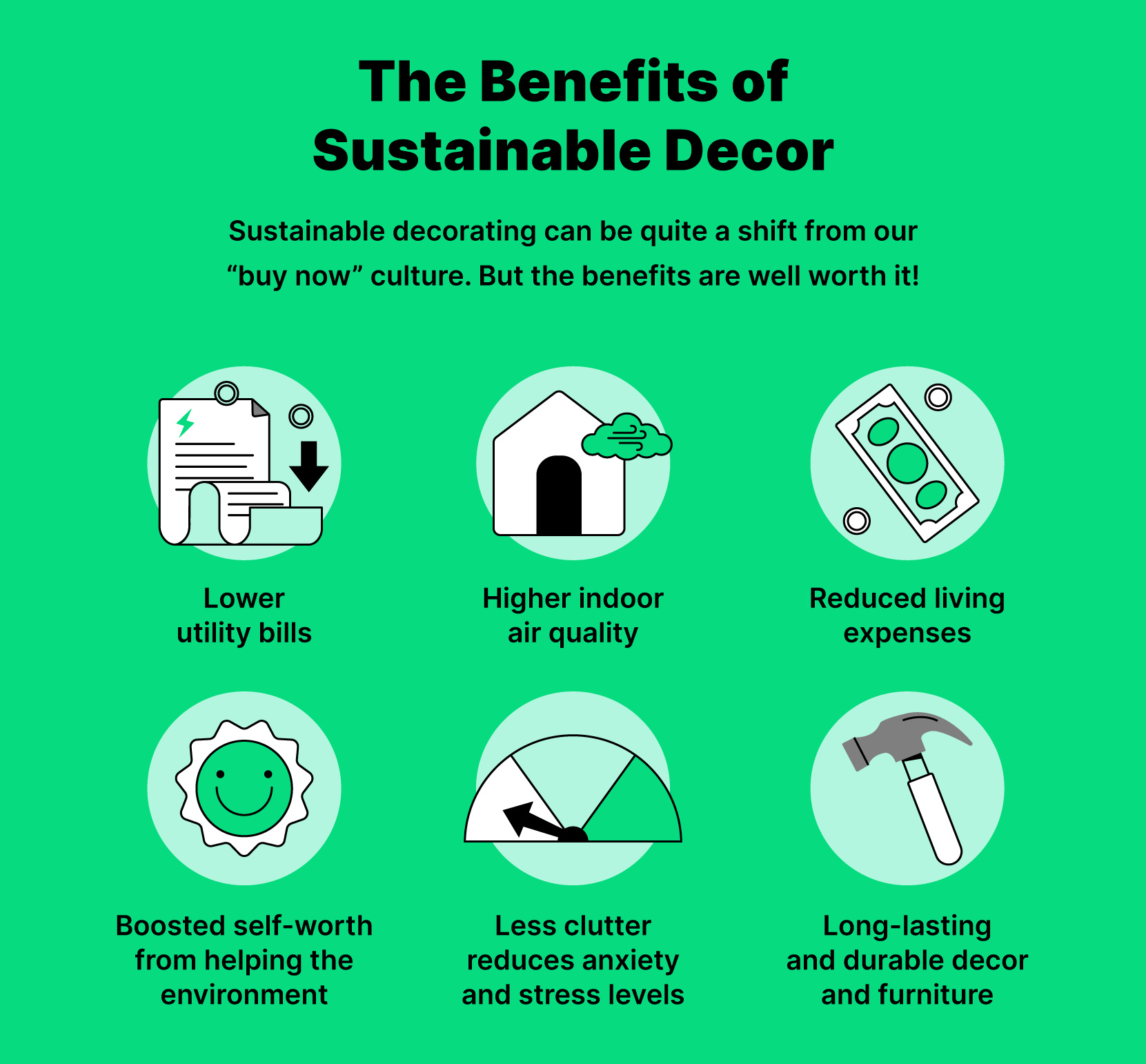
Protect your finds with home insurance
Home contents insurance (part of most insurance policies) is designed to have your back, meaning it’ll protect your newly thrifted and upcycled pieces from perils like damage or theft. If you’ve taken the plunge and bought new environmentally-friendly equipment, you can even protect your new additions with insurance riders like solar panel insurance and equipment breakdown coverage.
Though you may love the thrill of the hunt when thrift shopping, when it comes to home insurance, you shouldn’t have to work hard to get the protection you need.
Learn more about our modern home insurance options by giving us a call.




